Page 188 of 372
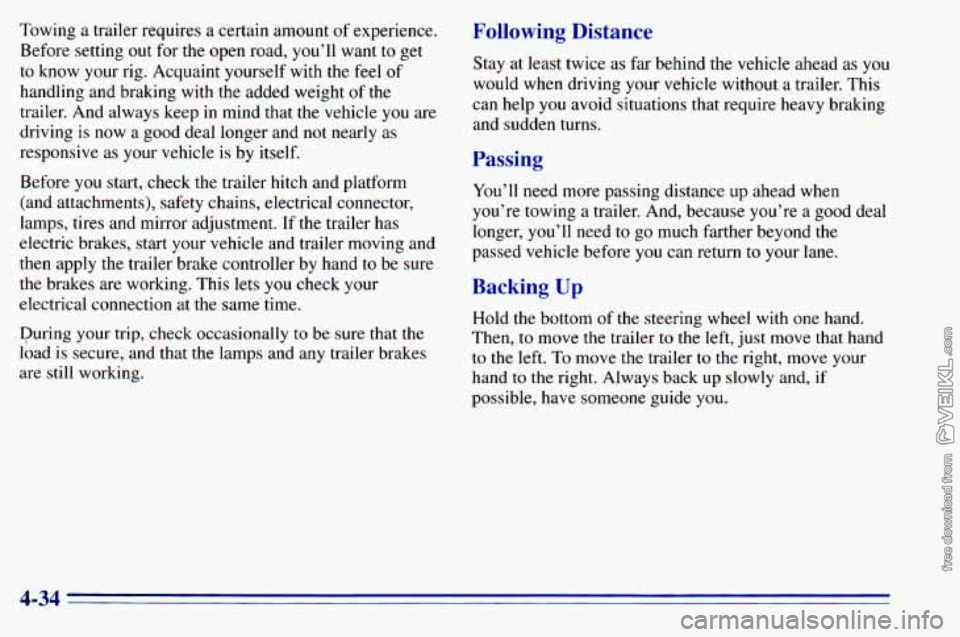
Towing a trailer requires a certain amount of experience.
Before setting out for the open road,
you’ll want to get
to know your rig. Acquaint yourself with the
feel of
handling and braking with the added weight of
the
trailer. And always keep in mind that the vehicle you are
driving is now a good deal longer and not nearly as
responsive as your vehicle is by itself.
Before
you start, check the trailer hitch and platform
(and attachments), safety chains, electrical connector,
lamps, tires and mirror adjustment. If the trailer has
electric brakes, start your vehicle and trailer moving and
then apply the trailer brake controller by hand to be sure
the brakes are working. This lets you check your
electrical connection at the same time.
During your trip, check occasionally to be sure that the
load is secure, and that the lamps and any trailer brakes
are still working.
lowing Distance
>ray at least twice as far behind the vehicle ahead as you
would when driving your vehicle without a trailer. This
can help you avoid situations that require heavy braking
and sudden turns.
Passing
You’ll need more passing distance up ahead when
you’re towing
a trailer. And, because you’re a good deal
longer,
you’ll need to go much farther beyond the
passed vehicle before you can return to your lane.
Backing Up
Hold the bottom of the steering wheel with one hand.
Then, to move the trailer
to the left, just move that hand
to the left. To move the trailer to the right, move your
hand to the right. Always back up slowly and,
if
possible, have someone guide you.
4-34
Page 194 of 372
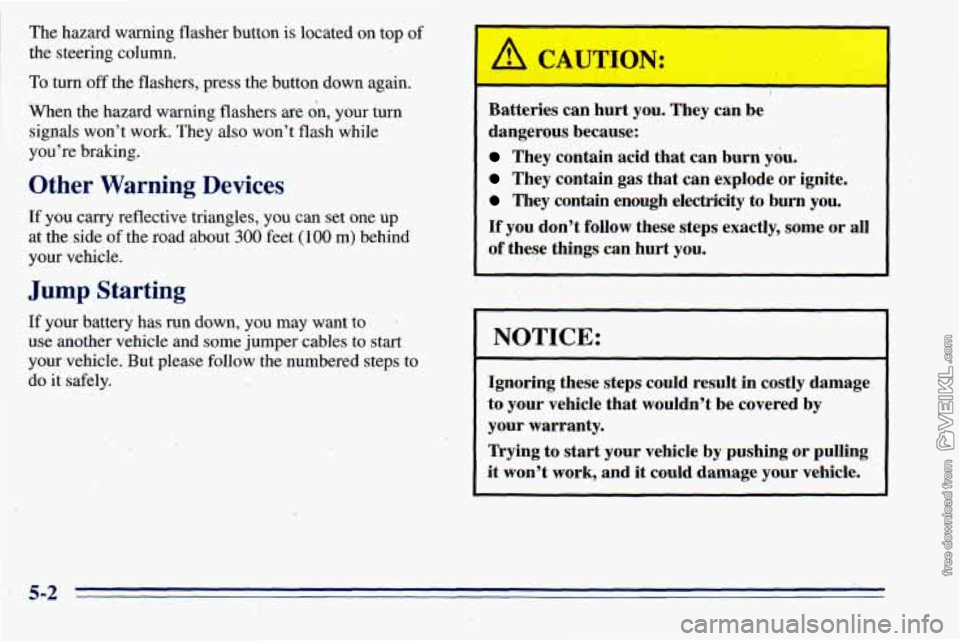
The hazard warning flasher button is located on top of
the steering column.
To turn off the flashers, press the button down again.
When the hazard warning flashers
are on, your turn
signals won’t work. They also won’t flash while
you’re braking.
Other Warning Devices
If you carry reflective triangles, you can set one up
at the side of the road about
300 feet (100 m) behind
your vehicle.
Jump Starting
If your battery has’run down, you may want to
use another vehicle and some jumper cables to start
yourvehicle. But please follow the numbered steps to
do it safely.
/i CAUTION:
Batteries can hurt you. They can be
dangerous because:
They contain acid that can burn you.
They contain gas that can explode or ignite.
They contain enough electricity to burn you.
If you don’t follow these steps exactly, some or all
of these
,. things can hurt you.,
I NOTICE: I
Ignoring these steps could result in’costly damage
to your vehicle that wouldn’t be covered by
your warranty.
Trying to start your vehicle
by pushing or pulling, ,
it won’t work, and it could damage your vehicle.
5-2
Page 200 of 372
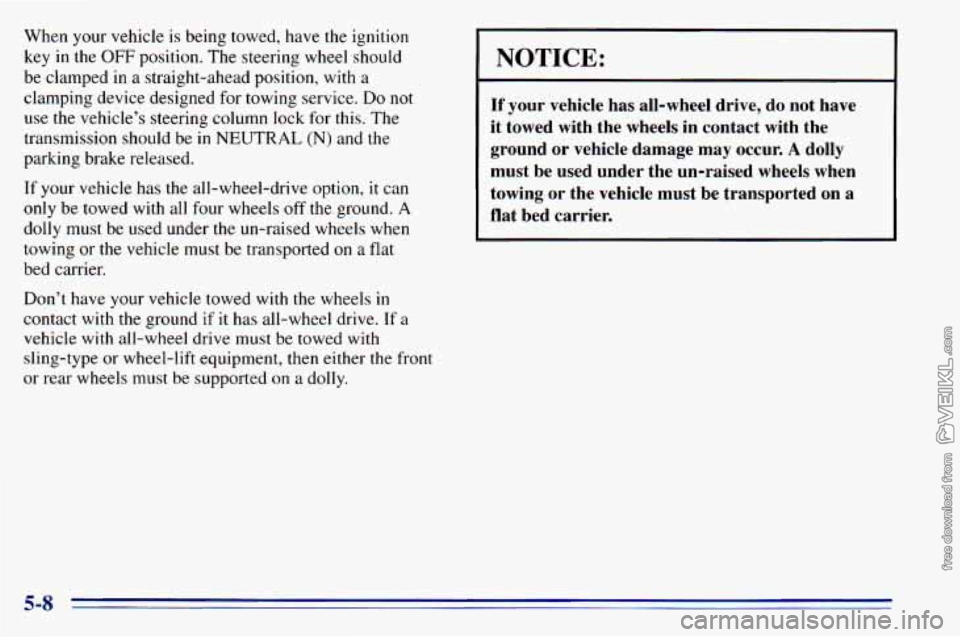
When your vehicle is being towed, have the ignition
key in the
OFF position. The steering wheel should
be clamped in a straight-ahead position, with
a
clamping device designed for towing service. Do not
use the vehicle’s steering column lock for this. The
transmission should be in NEUTRAL
(N) and the
parking brake released.
If your vehicle has the all-wheel-drive option,
it can
only be towed with all four wheels
off the ground. A
dolly must be used under the un-raised wheels when
towing or the vehicle must be transported
on a flat
bed carrier.
Don’t have your vehicle towed
with the wheels in
contact with the ground if it has all-wheel drive. If a
vehicle with all-wheel drive must be towed with
sling-type or wheel-lift equipment, then either the front
or rear wheels must be supported on a dolly.
NOTICE:
If your vehicle has all-wheel drive, do not have
it towed with the wheels in contact with the
ground or vehicle damage may occur.
A dolly
must be used under the un-raised wheels when
towing or the vehicle must be transported
on a
flat bed carrier.
5-8
Page 214 of 372
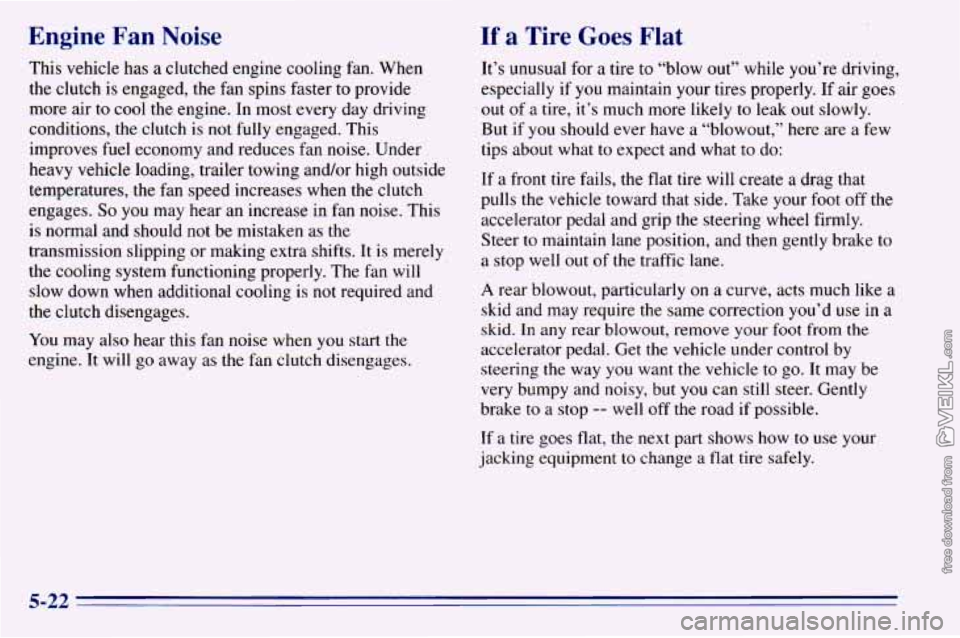
Engine Fan Noise
This vehicle has a clutched engine cooling fan. When
the clutch is engaged, the fan spins faster to provide
more air
to cool the engine. In most every day driving
conditions, the clutch is not fully engaged. This
improves fuel economy and reduces fan noise. Under
heavy vehicle loading, trailer towing and/or high outside
temperatures,
the fan speed increases when the clutch
engages.
So you may hear an increase in fan noise. This
is normal and should not be mistaken as the
transmission slipping or making extra shifts. It is merely
the cooling system functioning properly. The fan will
slow down when additional cooling is
not required and
the clutch disengages.
You may also hear this fan noise when
you start the
engine. It will go away as the fan clutch disengages.
If a Tire Goes Flat
It’s unusual for a tire to “blow out” while you’re driving,
especially if
you maintain your tires properly. If air goes
out of a tire, it’s much more likely to leak out slowly.
But if you should ever have a 4‘blowout,” here are a few
tips about what
to expect and what to do:
If a front tire fails, the flat tire will create a drag that
pulls the vehicle toward that side. Take your foot off the
accelerator pedal and grip the steering wheel firmly.
Steer to maintain lane position, and then gently brake to
a stop well
out of the traffic lane.
A rear blowout, particularly on a curve, acts much like a
skid and may require the same correction you’d use in a
skid.
In any rear blowout, remove your foot from the
accelerator pedal. Get the vehicle under control by steering the way
you want the vehicle to go. It may be
very bumpy and noisy, but
you can still steer. Gently
brake
to a stop -- well off the road if possible.
If a tire goes flat, the next part shows how to
use your
jacking equipment to change a flat tire safely.
5-22
Page 229 of 372
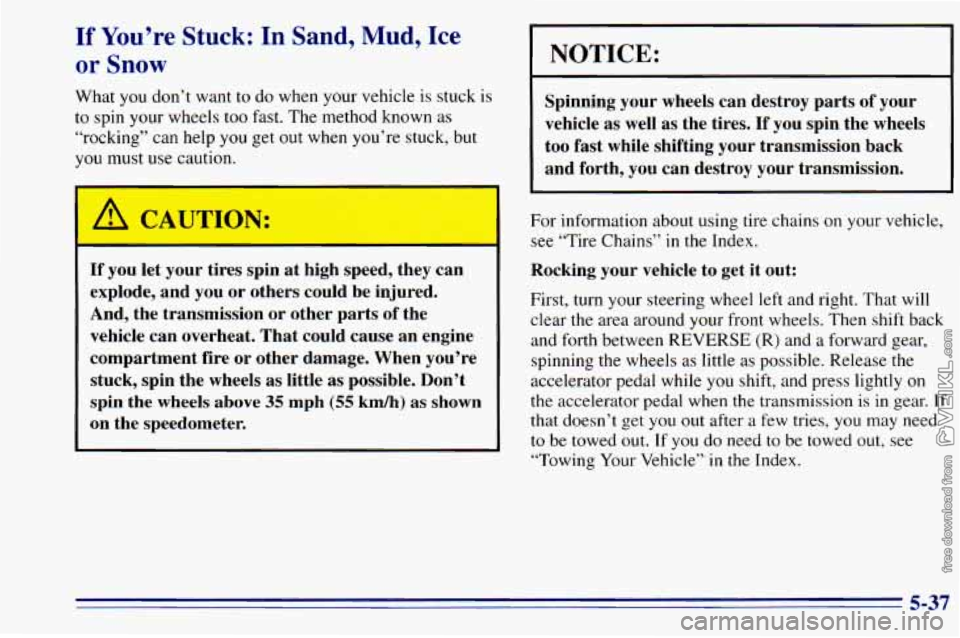
If You’re Stuck: In Sand, Mud, Ice
or Snow
What you don’t want to do when your vehicle is stuck is
to spin your wheels too fast. The method known as
“rocking” can help
you get out when you’re stuck, but
you must use caution.
A CAUTION:’
I
If you let your tires spin at high speed, they can
explode, and you or others could be injured.
And, the transmission or other parts of the
vehicle can overheat. That could cause an engine
compartment fire or other damage. When you’re
stuck, spin the wheels
as little as possible. Don’t
~ spin the wheels above 35 mph (55 km/h) as shown
~ on the speedometer.
I
NOTICE:
Spinning your wheels can destroy parts of your
vehicle
as well as the tires. If you spin the wheels
too fast while shifting your transmission back
and forth, you can destroy your transmission.
For information about using tire chains
on your vehicle,
see “Tire Chains” in
the Index.
Rocking your vehicle to get it out:
First, turn your steering wheel left and right. That will
clear the area around your front wheels. Then shift back
and forth between REVERSE
(R) and a forward gear,
spinning the wheels as little as possible. Release the
accelerator pedal while you shift, and press lightly
on
the accelerator pedal when the transmission is in gear. If
that doesn’t get
you out after a few tries, you may need
to be towed out. If you do need to be towed out, see
“Towing Your Vehicle’’’ in the Index.
5-37
Page 239 of 372
When you open the hood, this is what you will see:
-
A. Windshield Washer Fluid Fill Location
B. Coolant Fill Location
C. Oil Dipstick Location
D. Transmission Dipstick/Fill Location
E. Air Cleaner
6-9
F. Oil Fill Location
G. Brake Master Cylinder Reservoir
H. Power Steering Fluid Reservoir
I. Battery
Page 260 of 372
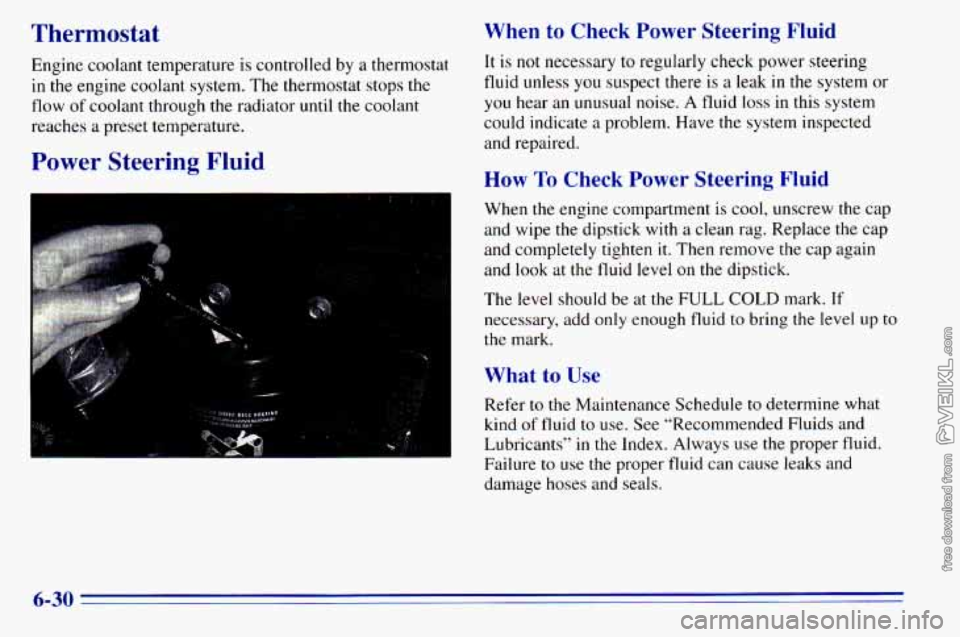
Thermostat When to Check Power Steering Fluid
Engine coolant temperature is controlled by a thermostat It is not necessary to reg,ularlY check Power steering
in the engine coolant system. The thermostat stops the fluid unless you suspect there is a leak in the system or
flow
of coolant through the radiator until the coolant you
hear an unusual noise. A fluid loss in this system
reaches a preset temperature. could indicate
a problem. Have the system inspected
and remired.
Power Steering Fluid
I
How To Check Power Steering Fluid
When the engine compartment is cool, unscrew the cap
and wipe
the dipstick with a clean rag. Replace the cap
and completely tighten
it. Then remove the cap again
and look at the fluid level
on the dipstick.
The level should be at the
FULL COLD mark. If
necessary, add only enough fluid to bring the level up to
the mark.
What to Use
Refer to the Maintenance Schedule to determine what
kind
of fluid to use. See “Recommended Fluids and
Lubricants’’
in the Index. Always use the proper fluid.
Failure to use the proper fluid can cause leaks and
damage hoses and seals.
6-30
Page 306 of 372
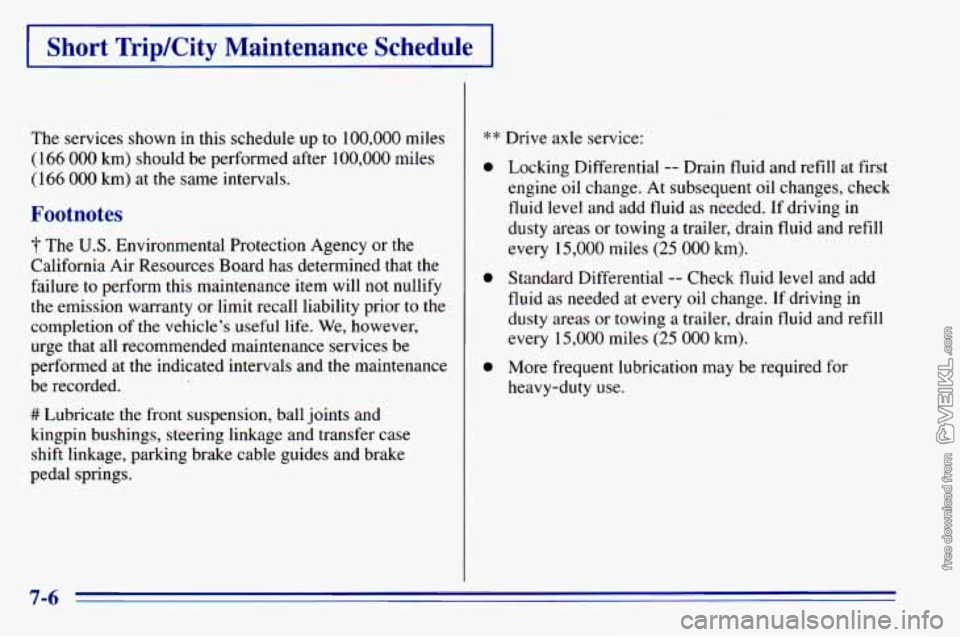
Short Trip/City Maintenance Schedule
The services shown in this schedule up to 100,000 miles
(166
000 km) should be performed after 100,000 miles
(166
000 km) at the same intervals.
Footnotes
3- The U.S. Environmental Protection Agency or the
California Air Resources Board has determined that the
failure
to perform this maintenance item will not nullify
the emission warranty or limit recall liability prior
to the
completion
of the vehicle’s useful life. We, however,
urge that all recommended maintenance services be
performed at the indicated intervals and the maintenance
be recorded.
# Lubricate the front suspension, ball joints and
kingpin bushings, steering linkage and transfer case
shift linkage, parking brake cable guides and brake
pedal springs. Drive
a
a
a
a
lxle service:
Locking Differential
-- Drain fluid and refill at first
engine oil change. At subsequent oil changes, check
fluid level and add fluid as needed. If driving in
dusty areas or towing a trailer, drain fluid and refill
every
15,000 miles (25 000 km).
Standard Differential
-- Check fluid level and add
fluid as needed
at every oil change. If driving in
dusty areas or towing a trailer, drain fluid and refill
every
15,000 miles (25 000 km).
More frequent lubrication may be required for
heavy-duty use.
7-6